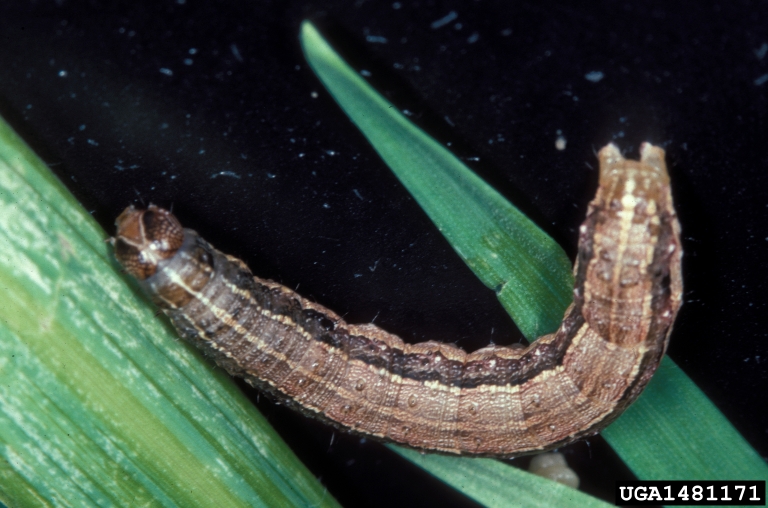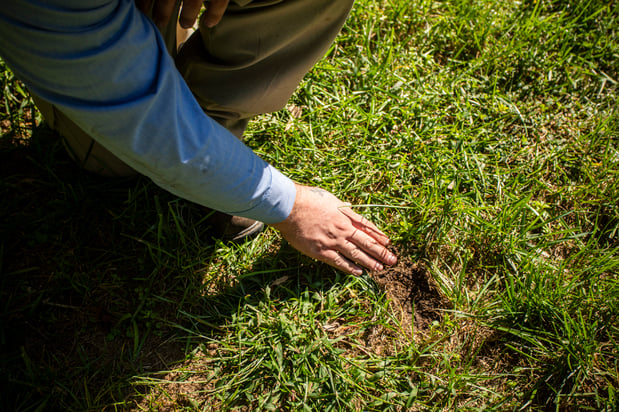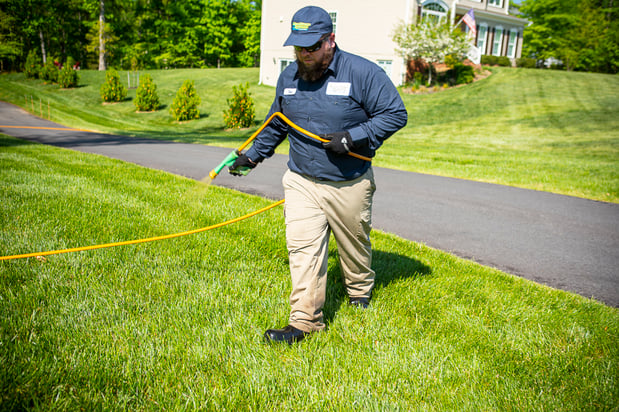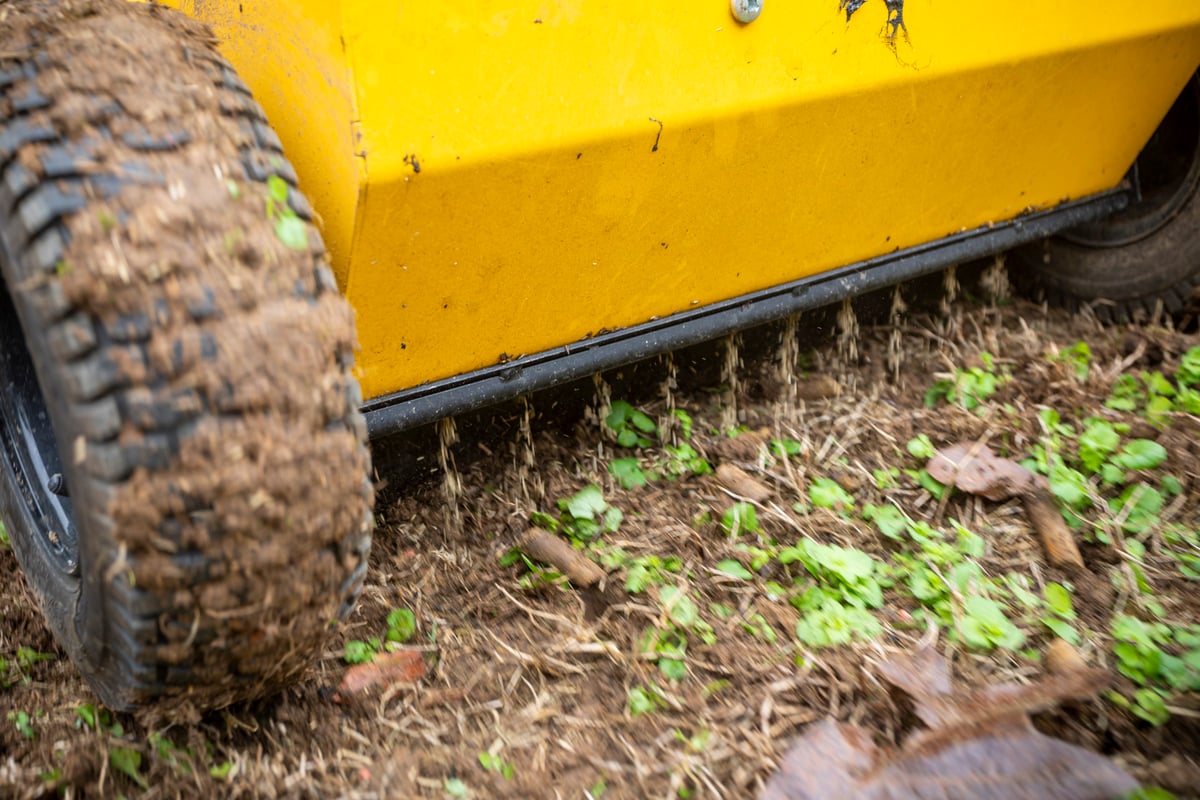Armyworm Control in Maryland: What Are They & How to Get Rid of Them
There could be troops invading your Maryland lawn right now … but you might not hear them marching in.
In fact, you might notice the damage they do to your lawn before you see them. We’re talking, of course, about armyworms. And they're after one thing: your lawn.
Armyworms get their name from how they move across your lawn in an army-like way – leaving dead grass in their wake.
Let’s learn more about this troop of invaders and all about armyworm control in Maryland.
All About Armyworm Control in Maryland
No one wants insects chewing up their lawn.
But learning a bit about armyworms in grass and how to get rid of armyworms can empower you with some knowledge that can help you better control these pests and keep them at bay.
What Do Armyworms Look Like?
You’re probably wondering, “What are armyworms?”
 Their larvae are 1-inch to 1.5-inches long and dark greenish-brown to black with long, white, orange, and dark brown stripes along the abdomen.
Their larvae are 1-inch to 1.5-inches long and dark greenish-brown to black with long, white, orange, and dark brown stripes along the abdomen.
The adult moths have 1-inch long bodies with a 1.5-inch wingspan, a tan body and a tiny white spot centered on each forewing.
The Life Cycle of Armyworms
Adult armyworms usually lay eggs on flat leaves of trees and flowers or even on patio furniture and light posts. This might be another key to identifying armyworms in grass. They come into your space by catching a ride on air currents and then dropping down to settle in.
 Each female can lay egg masses containing between 100 and 500 or more armyworm eggs. The eggs hatch five to seven days later. The fall armyworm larvae are what eat their way through your lawn.
Each female can lay egg masses containing between 100 and 500 or more armyworm eggs. The eggs hatch five to seven days later. The fall armyworm larvae are what eat their way through your lawn.
Signs of Armyworm Damage
Early feeding damage looks like drought-stressed grass, but can quickly progress to complete browning if there are a lot of armyworms in grass present.
Look closely and you’ll see ragged holes in your individual grass blades. Grass may be eaten down to the ground, creating these brown patches.
Another sign of armyworms includes a lacy or transparent effect on your grass blades where they have been chewed.
 Armyworms prefer new sod or newly seeded grass.
Armyworms prefer new sod or newly seeded grass.
How to Get Rid of Armyworms
First, if you’re in an area that is suspected to have fall armyworms, you can look for sticky egg masses to appear on buildings, patio sets, decor, plants, and other outdoor surfaces.
 That’s when you can get ahead of fall armyworms, which is the best way to avoid their damage. Armyworm control in Maryland can happen with an insecticide treatment, But since this pest can have multiple generations per year, Natural Green, serving Central and Southern Maryland, recommends its flea and tick control program, which includes 4 to 6 applications per year from April to November and does well at keeping fall armyworms at bay, in addition to fleas and ticks.
That’s when you can get ahead of fall armyworms, which is the best way to avoid their damage. Armyworm control in Maryland can happen with an insecticide treatment, But since this pest can have multiple generations per year, Natural Green, serving Central and Southern Maryland, recommends its flea and tick control program, which includes 4 to 6 applications per year from April to November and does well at keeping fall armyworms at bay, in addition to fleas and ticks.
Repairing Armyworm Damaged Grass
If armyworms have come through and destroyed your lawn, you may be wondering how you can get your great green lawn back.
If armyworms in grass feed on the upper portion of your grass blades, they might recover on their own with proper care.
 But if an infestation is severe, reseeding to reestablish the lawn is necessary. This is because the feeding is like mowing your lawn too short, removing way too much of the plant at once to the point where it can’t survive the shock.
But if an infestation is severe, reseeding to reestablish the lawn is necessary. This is because the feeding is like mowing your lawn too short, removing way too much of the plant at once to the point where it can’t survive the shock.
Trust Natural Green For Armyworm Control In Central and Southern Maryland
Armyworms in grass are pests that start coming into Maryland lawns in July and linger through August and September. Once the weather gets hot, it’s a pest you want to stay on top of to avoid severe lawn damage.
But if you’re not sure what you’re seeing is armyworm damage or you’d like to confirm your findings, give Natural Green a call. We’d love to help you with armyworm control in Maryland. Our experts are trained at spotting this pest and getting rid of it before it does too much damage to your lawn.
Ready to stop the armyworms in your Central and Southern Maryland lawn? Request a free quote today. We’ll review our options together so you can make the best choice for you. Then you can sit back and enjoy your yard – worry free!
Image Source: armyworm caterpillar, adult armyworm
There could be troops invading your Maryland lawn right now … but you might not hear them marching in.
In fact, you might notice the damage they do to your lawn before you see them. We’re talking, of course, about armyworms. And they're after one thing: your lawn.
Armyworms get their name from how they move across your lawn in an army-like way – leaving dead grass in their wake.
Let’s learn more about this troop of invaders and all about armyworm control in Maryland.
All About Armyworm Control in Maryland
No one wants insects chewing up their lawn.
But learning a bit about armyworms in grass and how to get rid of armyworms can empower you with some knowledge that can help you better control these pests and keep them at bay.
What Do Armyworms Look Like?
You’re probably wondering, “What are armyworms?”
 Their larvae are 1-inch to 1.5-inches long and dark greenish-brown to black with long, white, orange, and dark brown stripes along the abdomen.
Their larvae are 1-inch to 1.5-inches long and dark greenish-brown to black with long, white, orange, and dark brown stripes along the abdomen.
The adult moths have 1-inch long bodies with a 1.5-inch wingspan, a tan body and a tiny white spot centered on each forewing.
The Life Cycle of Armyworms
Adult armyworms usually lay eggs on flat leaves of trees and flowers or even on patio furniture and light posts. This might be another key to identifying armyworms in grass. They come into your space by catching a ride on air currents and then dropping down to settle in.
 Each female can lay egg masses containing between 100 and 500 or more armyworm eggs. The eggs hatch five to seven days later. The fall armyworm larvae are what eat their way through your lawn.
Each female can lay egg masses containing between 100 and 500 or more armyworm eggs. The eggs hatch five to seven days later. The fall armyworm larvae are what eat their way through your lawn.
Signs of Armyworm Damage
Early feeding damage looks like drought-stressed grass, but can quickly progress to complete browning if there are a lot of armyworms in grass present.
Look closely and you’ll see ragged holes in your individual grass blades. Grass may be eaten down to the ground, creating these brown patches.
Another sign of armyworms includes a lacy or transparent effect on your grass blades where they have been chewed.
 Armyworms prefer new sod or newly seeded grass.
Armyworms prefer new sod or newly seeded grass.
How to Get Rid of Armyworms
First, if you’re in an area that is suspected to have fall armyworms, you can look for sticky egg masses to appear on buildings, patio sets, decor, plants, and other outdoor surfaces.
 That’s when you can get ahead of fall armyworms, which is the best way to avoid their damage. Armyworm control in Maryland can happen with an insecticide treatment, But since this pest can have multiple generations per year, Natural Green, serving Central and Southern Maryland, recommends its flea and tick control program, which includes 4 to 6 applications per year from April to November and does well at keeping fall armyworms at bay, in addition to fleas and ticks.
That’s when you can get ahead of fall armyworms, which is the best way to avoid their damage. Armyworm control in Maryland can happen with an insecticide treatment, But since this pest can have multiple generations per year, Natural Green, serving Central and Southern Maryland, recommends its flea and tick control program, which includes 4 to 6 applications per year from April to November and does well at keeping fall armyworms at bay, in addition to fleas and ticks.
Repairing Armyworm Damaged Grass
If armyworms have come through and destroyed your lawn, you may be wondering how you can get your great green lawn back.
If armyworms in grass feed on the upper portion of your grass blades, they might recover on their own with proper care.
 But if an infestation is severe, reseeding to reestablish the lawn is necessary. This is because the feeding is like mowing your lawn too short, removing way too much of the plant at once to the point where it can’t survive the shock.
But if an infestation is severe, reseeding to reestablish the lawn is necessary. This is because the feeding is like mowing your lawn too short, removing way too much of the plant at once to the point where it can’t survive the shock.
Trust Natural Green For Armyworm Control In Central and Southern Maryland
Armyworms in grass are pests that start coming into Maryland lawns in July and linger through August and September. Once the weather gets hot, it’s a pest you want to stay on top of to avoid severe lawn damage.
But if you’re not sure what you’re seeing is armyworm damage or you’d like to confirm your findings, give Natural Green a call. We’d love to help you with armyworm control in Maryland. Our experts are trained at spotting this pest and getting rid of it before it does too much damage to your lawn.
Ready to stop the armyworms in your Central and Southern Maryland lawn? Request a free quote today. We’ll review our options together so you can make the best choice for you. Then you can sit back and enjoy your yard – worry free!
Image Source: armyworm caterpillar, adult armyworm
Share This
Topics: Lawn Care


